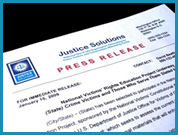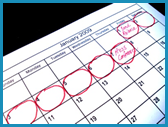
PAGE INDEX
a. Content
b. Format
Press Releases
 A press release provides information to the media that is timely, useful, and informative to their audiences. Editors and news directors receive hundreds of press releases each week and have to decide what is newsworthy. A press release is generally skimmed, so it needs simple, concise details that grab the attention of the person reviewing it.
A press release provides information to the media that is timely, useful, and informative to their audiences. Editors and news directors receive hundreds of press releases each week and have to decide what is newsworthy. A press release is generally skimmed, so it needs simple, concise details that grab the attention of the person reviewing it.
Not every event or activity is newsworthy. Press releases should always focus on news that is current or that will happen in the future. If it has already happened, it’s “old news.” It helps to establish priorities for media outreach (see “Developing a Media Plan” in this Section).
Prior to writing a press release, ask the following questions:27 27. Anne Seymour and Linda Lowrance, 1990, Media Relations, Washington, DC: National Center for Victims of Crime (formerly known as National Victim Center), (adapted in part).
- Is this information really newsworthy to the general public?
- What is the main point or feature of this news item?
- Should the press release be distributed to print or broadcast media, or both?
- Is there a creative angle that will make the release more interesting and appealing to editors and news directors?
 Many organizations and communities sponsor annual events to publicize victims’ rights and services (such as the “Silent Witness” displays during National Domestic Violence Awareness Month and “Take Back the Night” marches throughout the year). After a while, the media tend to view such events as “old news” unless they present a new hook. It is important to consider new angles that keep news fresh, and present innovative approaches in both press releases and public service announcements.
Many organizations and communities sponsor annual events to publicize victims’ rights and services (such as the “Silent Witness” displays during National Domestic Violence Awareness Month and “Take Back the Night” marches throughout the year). After a while, the media tend to view such events as “old news” unless they present a new hook. It is important to consider new angles that keep news fresh, and present innovative approaches in both press releases and public service announcements.
- Writing style and content should be succinct, descriptive, and avoid unnecessary information. With the exception of personal quotations, the text should be written in the “third person.”
- The headline should pique people’s interest and does not have to tell the whole story. It should be no more than 10 words.

- The first paragraph can be the “deal breaker.” It should include the “5 Ws” (who, what, when, where, why and how) written to immediately draw people in. For example: “A day without violence is the goal of (event, followed by the 5 Ws).”
- The second paragraph should explain the value and purpose of the event or activity, and why people should care about it.
- The body of the press release should include elements of human interest and articulate the theme of the information. For example—
- How this event or activity will make a positive difference in the lives of victims and the community.
- Any information about resources or speakers that are unique and have something special to offer.
- Quotations from victims and survivors or community leaders.
- The information should be factual, and language should avoid superlatives (the “best,” the “most”).
- Offer information that people can use. If it’s an event to attend, give a reason why they should attend. Offering a free publication or something interesting via a Web site makes the press release more relevant.
The standardized format for press releases is shown below. Some format considerations include—
- Press releases should be typed in a 12 point font (Arial, Verdana, or Times Roman) and double-spaced.
- “FOR IMMEDIATE RELEASE” indicates that the information in the release is ready to be published.
- The headline should not exceed 10 words and should fit on one line, centered, using capital letters in a bold font that is slightly larger than the text font.
- If a press release exceeds one page, type “more” on the bottom of the first page and at the top of the second page, type in bold:
Press release
(Topic)
Page two
- Type “END” in bold in the center at the end of the release.
- Always “spell check” the draft press release.
FOR IMMEDIATE RELEASE:
CONTACT: Contact person and organization affiliation
Area code/telephone number
E-mail address
Web site URL
HEADLINE OF THE PRESS RELEASE
City/State/Date – The first sentence should include the most important information to get the attention of the editor and encourage further reading.
Text of the press release—it is a good idea to keep the length to less than 600 words.
The last paragraph should always read: “For additional information about (topic of the release), contact (name) at (area code/telephone number) or visit (Web URL).
– END –
It is a good idea to have several people review the press release for content and accuracy, format, grammar, and spelling prior to sending it.
Your press release should be sent to the media 7 to 10 days in advance of the event or activity.





